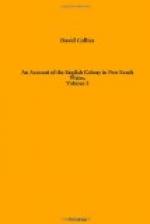Although Van Diemen’s land seems to possess few or none of those vast depths of soil with which the happiest spots of New South Wales are blessed; yet it seldom sickens the heart of its traveller with those extensive tracts which at once disarm industry, and leave the warmest imagination without one beguiling project.
In point of productive soil Mr. Bass gives the preponderance to Van Diemen’s land.
In one particular, which to the inhabitants of a civilized country is of the utmost importance, both countries are but too much alike: each is amply stored with water for the common purposes of life; but deficient in those large intersections of it which, in other more fortunate countries, so much facilitate the operations of man, and lead commerce to the door of even the most inland farmer.
Two rivers only, Port Dalrymple and the Derwent, are known to descend from Van Diemen’s land; and by Point St Vincent possibly there may be a third. But two rivers, or even three, bear but a scanty proportion to the bulk of the island.
On the 3rd of January they left the Derwent, and proceeded to the northward, coasting the east side of Frederick Henry Bay, which was for the most part high and steep to the sea. The figure of the shore, between what is now called Cape Basaltes and Cape Pillar, exhibited one of those great works of nature which seldom fall to excite surprise: it was all basaltic. The cape is a vast high wedge, which projects into the sea, surmounted by lofty single columns.
After passing Cape Pillar, some islands came in sight to the northward; but they did not fetch them, owing to the wind hanging in that quarter. On the following day, they reached within five or six miles of one of them, which in its general appearance bore some resemblance to Furneaux’s Islands. This group must be either Maria’s or Schouten’s islands, or both; but it was not determined to which they belonged.
On the 7th, having until that day had but indistinct views of the land, they saw Cape Barren Island. They did not pass through the channel, or passage, which divides Furneaux’s islands, but discovered why Captain Furneaux named the place the Bay of Shoals.
Early on the morning of the 8th they were among the islands lying off the Patriarchs. They were three in number; the largest of which was high, rocky, and barren, with a basis of granite, which, like that of Preservation Island, laid scattered about in large detached blocks. Mr. Bass landed upon the outermost, and found it well inhabited. The various tribes had divided it into districts. One part was white with gannets, breeding in nests of earth and dried grass. Petrels and penguins had their underground habitations in those parts of the island which had the most grass. The rocks of the shore, and blocks of granite, were occupied by the pied offensive shag and common gull; geese, red-bills and quails, lived in common, and the rest was appropriated to the seals,




